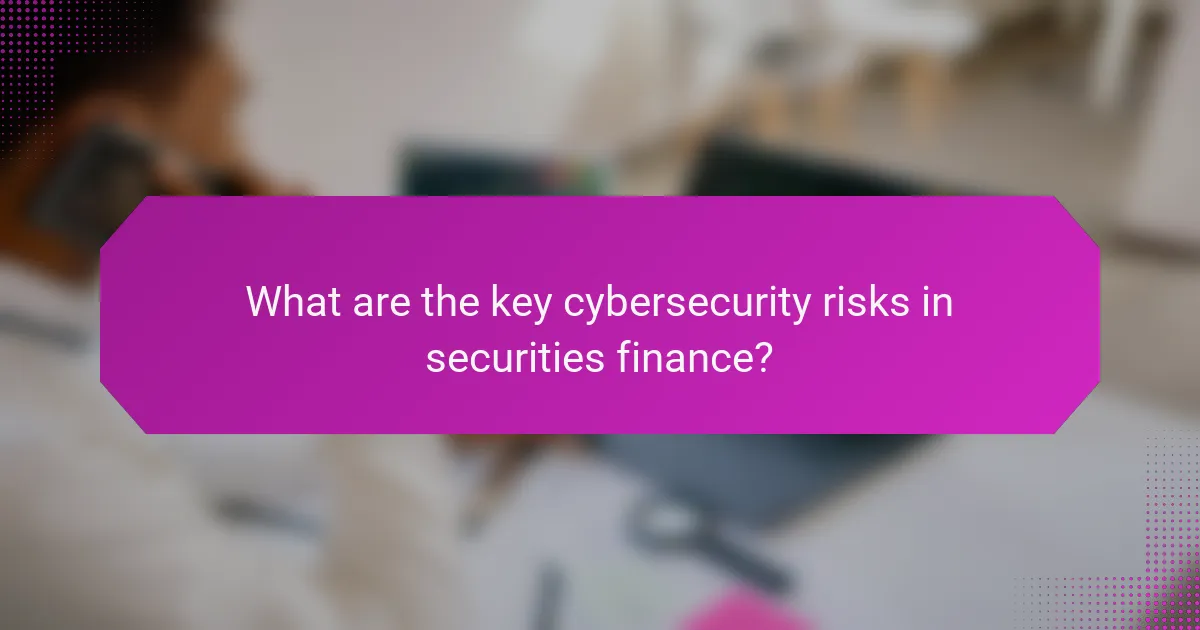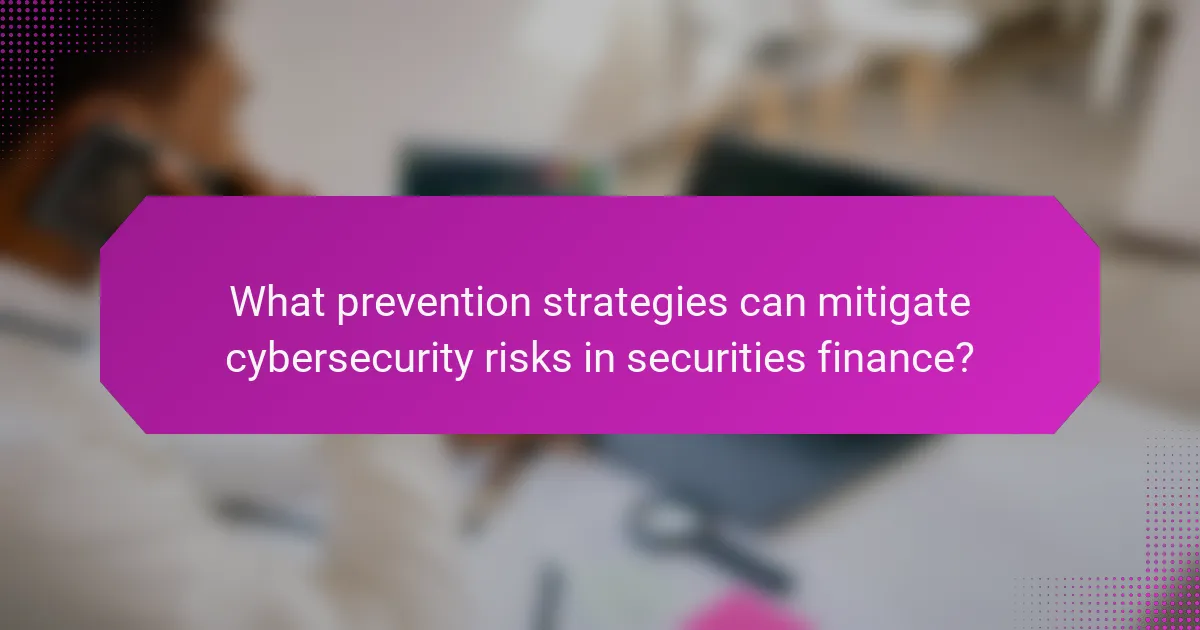Cybersecurity risks in securities finance encompass data breaches, insider threats, third-party vulnerabilities, phishing attacks, ransomware, and regulatory non-compliance. These risks can compromise sensitive financial information and disrupt operations, leading to potential fines and reputational damage. To mitigate these threats, firms are implementing robust cybersecurity measures such as software updates, employee training, multi-factor authentication, and regular security audits. Emerging trends include the use of artificial intelligence for threat detection, the adoption of zero-trust security models, and increased regulatory compliance, all aimed at enhancing the security and integrity of securities finance operations.

What are the key cybersecurity risks in securities finance?
Key cybersecurity risks in securities finance include data breaches, insider threats, and third-party vulnerabilities. Data breaches can lead to unauthorized access to sensitive financial information. Insider threats involve employees misusing their access for malicious purposes. Third-party vulnerabilities arise from reliance on external vendors, which can expose firms to additional risks. Phishing attacks also target employees to gain access to systems. Ransomware can disrupt operations by encrypting critical data. Regulatory non-compliance poses risks of fines and reputational damage. Each of these risks can significantly impact the integrity and security of securities finance operations.
How do these risks impact financial institutions?
Cybersecurity risks significantly impact financial institutions by increasing operational costs and exposing them to regulatory penalties. These risks can lead to data breaches, resulting in financial losses and reputational damage. A study by Accenture found that financial services face an average cost of $18 million per data breach. Additionally, regulatory compliance failures can incur fines and legal fees, further straining financial resources. Cyber incidents also disrupt business operations, leading to service outages that affect customer trust and satisfaction. This cascading effect can diminish market competitiveness and overall stability within the financial sector.
What specific vulnerabilities are present in securities finance systems?
Securities finance systems are vulnerable to several specific threats. These include inadequate access controls, which can lead to unauthorized access to sensitive data. Weak encryption methods expose data to interception during transmission. Poorly implemented software can contain bugs that hackers exploit. Additionally, systems may lack proper monitoring, allowing breaches to go undetected. Insider threats also pose a risk, as employees may misuse their access. Legacy systems often do not receive updates, making them susceptible to known exploits. Lastly, third-party integrations can introduce vulnerabilities if not properly managed. Each of these vulnerabilities can compromise the integrity and security of securities finance operations.
How do external threats differ from internal threats in this context?
External threats originate from outside the organization, while internal threats arise from within. External threats often include hackers, malware, and phishing attacks targeting systems and data. These threats exploit vulnerabilities in the organization’s defenses. In contrast, internal threats can stem from employees or contractors who may intentionally or unintentionally compromise security. For example, an employee may mishandle sensitive information or fall victim to social engineering tactics. According to a 2022 report by IBM, 60% of data breaches involved insiders, highlighting the significance of internal threats. Both types of threats require distinct prevention strategies and compliance measures to mitigate risks effectively.
What types of cyber attacks are most common in securities finance?
Phishing attacks are the most common cyber attacks in securities finance. These attacks often involve fraudulent emails that impersonate legitimate entities. Cybercriminals aim to steal sensitive information such as login credentials. Ransomware attacks also pose significant threats. They encrypt critical data and demand payment for its release. Distributed Denial of Service (DDoS) attacks disrupt services by overwhelming systems with traffic. Insider threats can occur when employees misuse access to sensitive data. Malware infections can compromise systems and lead to data breaches. According to a 2022 report by the Financial Services Information Sharing and Analysis Center (FS-ISAC), these types of attacks have increased by over 40% in the finance sector.
How do phishing attacks target securities finance professionals?
Phishing attacks target securities finance professionals by impersonating trusted entities to steal sensitive information. Attackers often use emails that appear to be from financial institutions or regulatory bodies. These emails may contain links to fake websites designed to harvest login credentials. Securities finance professionals are particularly vulnerable due to their access to confidential financial data. According to the 2022 Cybersecurity Report by the Financial Industry Regulatory Authority (FINRA), 70% of financial firms reported phishing attempts. Such attacks can lead to significant financial losses and regulatory penalties.
What role does ransomware play in securities finance vulnerabilities?
Ransomware significantly increases vulnerabilities in securities finance by targeting sensitive financial data. It disrupts operations by encrypting critical information, leading to financial losses and reputational damage. According to a report by the Cybersecurity and Infrastructure Security Agency, ransomware attacks in the financial sector have escalated by over 300% in recent years. These attacks can halt trading activities and compromise client trust. The high value of financial data makes securities firms attractive targets for cybercriminals. Additionally, the regulatory environment mandates strict compliance, which ransomware incidents can jeopardize. Overall, ransomware poses a serious threat to the integrity and stability of securities finance operations.

What prevention strategies can mitigate cybersecurity risks in securities finance?
Implementing robust cybersecurity measures can significantly mitigate risks in securities finance. Regularly updating software and systems helps protect against vulnerabilities. Employee training on cybersecurity awareness reduces the likelihood of human error. Multi-factor authentication adds an extra layer of security for accessing sensitive data. Conducting regular security audits identifies potential weaknesses in the system. Utilizing encryption for data storage and transmission safeguards sensitive information. Establishing incident response plans ensures quick recovery from potential breaches. Compliance with regulatory standards further strengthens security protocols.
How can organizations implement effective cybersecurity measures?
Organizations can implement effective cybersecurity measures by adopting a multi-layered security approach. This includes conducting regular risk assessments to identify vulnerabilities. Organizations should also establish strong access controls to limit data exposure. Implementing firewalls and intrusion detection systems is essential for monitoring network traffic. Regular software updates and patch management help protect against known exploits. Employee training on cybersecurity awareness reduces the risk of human error. Additionally, organizations should develop an incident response plan for swift action during breaches. According to a report by Cybersecurity Ventures, global cybersecurity spending is expected to exceed $1 trillion from 2017 to 2021, highlighting the increasing importance of robust cybersecurity measures.
What are the best practices for employee training on cybersecurity?
Effective employee training on cybersecurity includes regular training sessions, clear policies, and simulated phishing exercises. Regular training sessions keep employees updated on the latest threats and best practices. Clear policies outline acceptable behavior and procedures for reporting incidents. Simulated phishing exercises test employees’ awareness and response to potential attacks. These practices help reduce the risk of human error, which is a leading cause of data breaches. Research shows that organizations with ongoing training see a 70% reduction in successful phishing attacks. Therefore, implementing these best practices is essential for enhancing cybersecurity awareness and resilience within the workforce.
How does technology play a role in enhancing cybersecurity defenses?
Technology enhances cybersecurity defenses through advanced tools and techniques. These include firewalls, intrusion detection systems, and encryption methods. Firewalls block unauthorized access to networks. Intrusion detection systems monitor for suspicious activities. Encryption protects sensitive data from unauthorized access. Additionally, artificial intelligence improves threat detection and response times. According to a 2021 report by Cybersecurity Ventures, AI-driven security solutions can reduce response times by up to 90%. Regular software updates and patches also strengthen defenses against vulnerabilities. Overall, technology plays a critical role in creating a robust cybersecurity framework.
What frameworks and standards should be followed for cybersecurity compliance?
The primary frameworks and standards for cybersecurity compliance include NIST Cybersecurity Framework, ISO/IEC 27001, and PCI DSS. The NIST Cybersecurity Framework provides guidelines for managing cybersecurity risks. It is widely adopted in various sectors. ISO/IEC 27001 focuses on information security management systems. This standard helps organizations manage sensitive data effectively. PCI DSS is essential for organizations handling credit card transactions. It ensures secure processing and storage of cardholder information. Compliance with these frameworks enhances security posture and mitigates risks. Organizations can demonstrate accountability and commitment to cybersecurity by adhering to these standards.
How do regulatory requirements affect cybersecurity practices in securities finance?
Regulatory requirements significantly shape cybersecurity practices in securities finance. They mandate organizations to implement specific security measures to protect sensitive financial data. Compliance with regulations like the SEC’s Regulation S-P and GDPR ensures that firms adopt robust encryption and access controls. These regulations often require regular risk assessments and audits to identify vulnerabilities. Additionally, they enforce incident response protocols to mitigate potential breaches. Failure to comply can result in severe penalties, thus incentivizing firms to prioritize cybersecurity. Overall, regulatory frameworks drive the adoption of comprehensive cybersecurity strategies in the securities finance sector.
What are the consequences of non-compliance with cybersecurity regulations?
Non-compliance with cybersecurity regulations can lead to severe consequences. Organizations may face hefty fines, often reaching millions of dollars. For instance, the General Data Protection Regulation (GDPR) can impose fines up to 4% of annual global turnover. Additionally, non-compliance can result in legal actions from affected parties. This may include lawsuits and compensation claims. Reputational damage is another consequence, leading to loss of customer trust. Organizations may also experience operational disruptions due to security breaches. These breaches can compromise sensitive data and lead to significant recovery costs. Overall, the consequences of non-compliance can severely impact an organization’s financial and operational stability.

What are the emerging trends in cybersecurity for securities finance?
Emerging trends in cybersecurity for securities finance include increased use of artificial intelligence and machine learning. These technologies enhance threat detection and response capabilities. Moreover, there is a growing focus on zero-trust security models. This approach requires verification at every access point, reducing the risk of insider threats.
Additionally, regulatory compliance is becoming more stringent. Financial institutions must adhere to evolving regulations like GDPR and CCPA. This trend drives the adoption of advanced data protection measures. Another notable trend is the rise of blockchain technology. It offers enhanced security and transparency in transactions.
Furthermore, cybersecurity awareness training for employees is gaining importance. Human error remains a significant vulnerability in security breaches. Organizations are investing in regular training programs to mitigate this risk. Overall, these trends reflect a proactive shift towards robust cybersecurity in the securities finance sector.
How is artificial intelligence shaping cybersecurity strategies?
Artificial intelligence is significantly shaping cybersecurity strategies by enhancing threat detection and response. AI algorithms analyze vast amounts of data to identify anomalies that may indicate security breaches. These systems can learn from previous attacks, improving their predictive capabilities. According to a report by McKinsey, AI can reduce the time to detect a breach by up to 80%. Additionally, AI-driven automation helps in responding to threats faster than human teams can. This efficiency is crucial in sectors like securities finance, where timely action is essential to mitigate risks. AI also supports continuous monitoring, ensuring that systems remain secure against evolving threats.
What are the potential benefits of AI in threat detection?
AI enhances threat detection by improving accuracy and speed in identifying potential security threats. It analyzes vast amounts of data in real time. This capability allows for faster response times to incidents. AI can reduce false positives, ensuring security teams focus on genuine threats. Machine learning algorithms adapt to new threats over time. This adaptability is crucial in the ever-evolving landscape of cybersecurity. AI systems can identify patterns and anomalies that human analysts might miss. Research indicates that organizations using AI for threat detection experience a significant decrease in response times.
How can machine learning enhance incident response in securities finance?
Machine learning can enhance incident response in securities finance by automating threat detection and analysis. It processes vast amounts of data quickly, identifying patterns that indicate potential security breaches. Machine learning algorithms can learn from historical incidents, improving their accuracy over time. This capability allows for real-time monitoring of transactions and alerts on suspicious activities. For instance, firms utilizing machine learning have reported a 30% reduction in response time to incidents. Additionally, machine learning can prioritize incidents based on severity, enabling security teams to focus on the most critical threats first. These advancements lead to more efficient and effective incident response strategies in the securities finance sector.
What practical steps can organizations take to improve their cybersecurity posture?
Organizations can improve their cybersecurity posture by implementing a multi-layered security strategy. This includes regular security assessments to identify vulnerabilities. Employee training on cybersecurity best practices is essential. Organizations should also enforce strong password policies and multi-factor authentication. Updating and patching systems regularly helps protect against known threats. Utilizing firewalls and intrusion detection systems adds another layer of defense. Data encryption ensures sensitive information remains secure. Finally, developing an incident response plan prepares organizations to react swiftly to potential breaches. These steps significantly reduce the risk of cyber threats in the securities finance sector.
How can regular security assessments help identify vulnerabilities?
Regular security assessments help identify vulnerabilities by systematically evaluating systems and processes. These assessments involve scanning for weaknesses in software, hardware, and network configurations. They provide detailed reports on potential risks and security gaps. Consistent assessments allow organizations to track changes in their security posture over time. This ongoing evaluation helps prioritize remediation efforts effectively. According to a 2020 report by the Ponemon Institute, organizations that conduct regular assessments reduce their risk of data breaches by 30%. Regular assessments also ensure compliance with industry regulations, which often require vulnerability management practices.
What role does incident response planning play in cybersecurity preparedness?
Incident response planning is crucial for cybersecurity preparedness. It establishes a structured approach to detect, respond to, and recover from security incidents. Effective planning minimizes the impact of breaches on operations and data integrity. According to a 2020 report by the Ponemon Institute, organizations with an incident response plan can reduce the average cost of a data breach by $2.45 million. This planning enhances communication among stakeholders during an incident, ensuring timely and coordinated responses. Furthermore, it helps organizations comply with regulatory requirements, thereby avoiding potential fines. Overall, incident response planning is a foundational component of a robust cybersecurity strategy.
The main entity of the article is cybersecurity risks in securities finance. The article provides a comprehensive overview of key cybersecurity threats such as data breaches, insider threats, and third-party vulnerabilities, highlighting their impact on financial institutions and specific vulnerabilities within securities finance systems. It discusses common cyber attacks, including phishing and ransomware, and outlines effective prevention strategies, compliance frameworks, and the role of technology in enhancing cybersecurity defenses. Additionally, the article addresses the importance of employee training and incident response planning to mitigate risks and ensure regulatory compliance within the sector.
